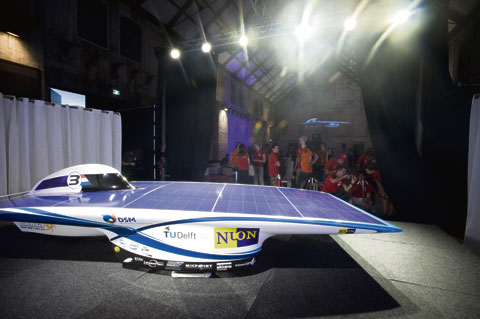The solar-powered racing car Nuna 6 was presented to the press this week. Will it be faster than its predecessors? New regulations on the type of solar cells allowed have turned the race into a whole new ball game.
This year’s race through the desert of Australia will be nerve breaking, if we are to believe Mike Hoogstraten (23), the chief engineer of the TU Delft student team. “Whereas the time differences between participants were hours during the previous races, this years’ differences will probably only be minutes,” he says.
TU Delft has a reputation to uphold when it comes to solar racing. Four times in a row the Delft students have won the race in which dozens of student teams from all over the world participate and which is held every other year in October. The teams have to cross the desert (3000 kilometers from Darwin to Adelaide) in five days. In 2009, Nuna was dethroned by a team from the Japanese University of Tokai, coming in second. Still not bad.
But whether the Delft students will be able to shake off the vast majority of their opponents this year remains to be seen. Teams are only allowed to carry 3 square meters of very efficient gallium arsenide solar cell panels on their car (efficiency of 34 percent) instead of the 6 square meters in previous years. It’s either this, or they can fall back on the less efficient solar panels made of mono crystalline silicon (efficiency of 20 to 22 percent), of which 6 square meters are still allowed. The Nuna 6 team decided to use 6 square meters of silicon panels.
This measure creates a more equal playing field, since not all teams could afford the more expensive gallium arsenide panels. The fastest teams, including Nuna, used gallium arsenide during previous races. With the new rules now in force, they will face fierce competition from teams that have been doing fairly well with silicon cells, such as the Australian teams Auroa and Sunswift.
Hoogstraten is optimistic however. Rumours were that the Delft team won thanks to their gallium arsenide. The student believes this year is his team’s chance to prove these rumours wrong. “The solar panel is an important part of the solar car, but to win a solar race the solar car must have a well-designed aerodynamic shape as well as a strong light weight structure. Now is our chance to once again prove that the strength of our team lies in combining all these elements .”
De decaan zei dat hij de komende tijd gaat kijken hoe hij deze bezuiniging gaat opvangen. “We hopen via natuurlijk verloop. In bepaalde sectoren kan het meer gevolgen hebben dan in andere sectoren.”
Bouwkunde ontvangt dit jaar 33,7 miljoen euro, maar dit zal in 2014 vanwege de herijking 28,5 miljoen zijn. “Vijf miljoen euro is echt heel erg ingrijpend”, zei Patijn. “Het college van bestuur wil het grootste deel al in de begroting van 2011 gerealiseerd hebben.”
De decaan noemde het een ‘bijna onmogelijke taak om in zo’n korte tijd zoveel te bezuinigen’. “Wij kunnen niet méér bezuinigen, want we hebben veel studenten. We hebben de afgelopen jaren al behoorlijk ingeleverd.”
Een medewerkster vroeg vervolgens of al bekend is voor welke nieuwe investeringen de TU nu gaat bezuinigen. Patijn antwoordde dat de TU geld vrijmaakt om noodzakelijke bouwprojecten te realiseren. “Nieuwbouw voor Technische Natuurwetenschappen, de verbouwing van Civiele Techniek & Geowetenschappen, het Learning Centre en BK City Slim.”
Dit laatste project betreft het duurzamer maken van het pand van Bouwkunde. Patijn wees er op dat het gebruik ervan ook moet verbeteren vanwege ruimtegebrek. Desgevraagd zei hij zich te kunnen voorstellen dat er een gevoel heerst dat de TU meer in stenen dan in mensen investeert. “Maar we lopen als TU achter op onderhoud.”



Comments are closed.